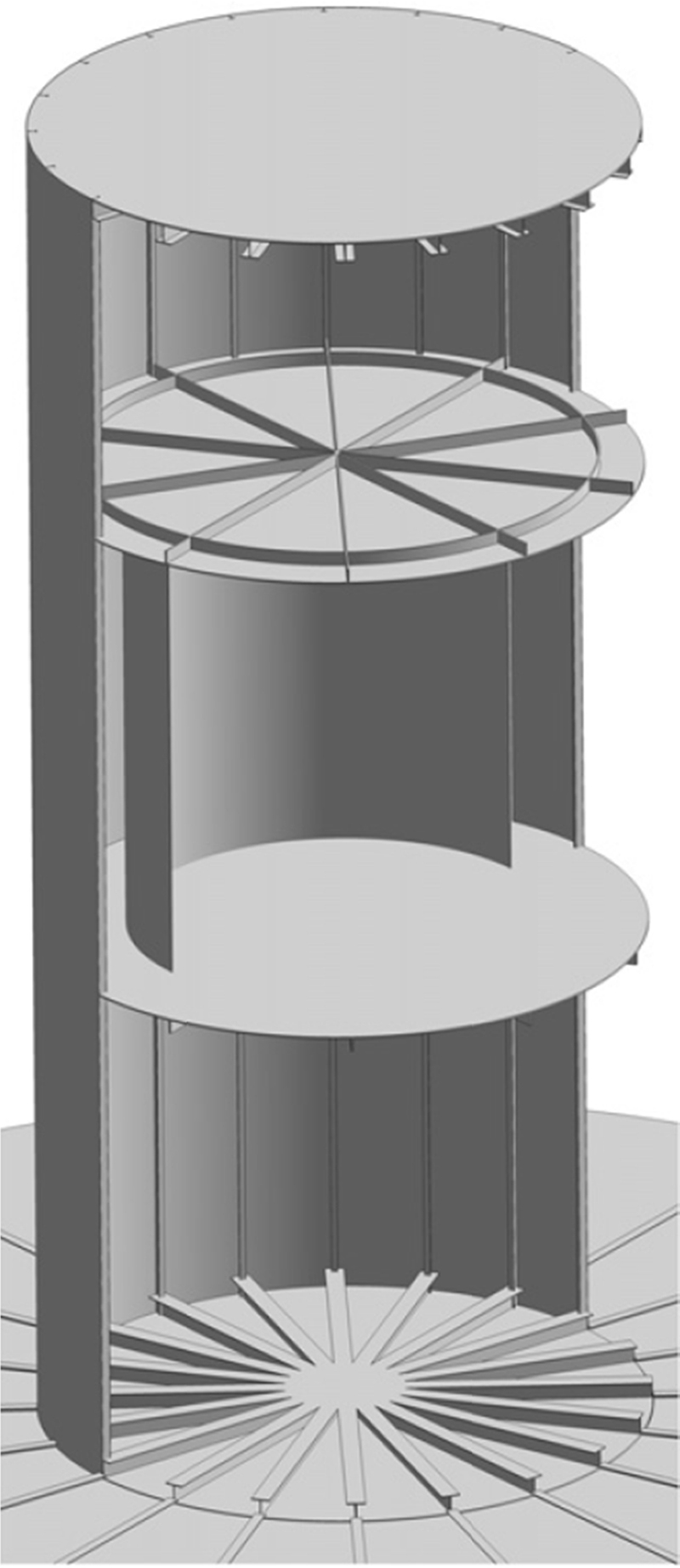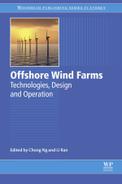ABS. Guide for Building and Classing Floating Offshore Wind Turbine Installations. 2013.
Ashuri T. Beyond Classical Upscaling: Integrated Aeroservoelastic Design and Optimization of Large Offshore Wind Turbines. Delft University of Technology; 2012. Available at: http://mdolab.engin.umich.edu/content/beyond-classical-upscaling-integrated-aeroservoelastic-design-and-optimization-large (accessed 01.12.14.).
Aubault A, Cermelli C, Roddier D. WindFloat: a floating foundation for offshore wind turbines part III: structural analysis. Engineering. 2009:1–8.
Blue H. Blue H – Concept. 2004. Available at: http://www.bluehgroup.com/concept/index.php (accessed 25.02.15.).
Blue H. Blue H – Products – Phase 1. 2004. Available at: http://www.bluehgroup.com/product/phase-1.php.
Borg M, Wang K, et al. A comparison of two coupled model of dynamics for offshore floating vertical axis wind turbines (VAWT). In: Proceedings of the ASME 2014 33rd International Conference on Ocean, Offshore and Arctic Engineering OMAE 2014. San Francisco, CA: ASME; 2014.
Borg M, Collu M. A comparison between the dynamics of horizontal and vertical axis offshore floating wind turbines. Philosophical Transactions of the Royal Society A. 2015;373(2035).
Borg M, Collu M. Frequency-domain characteristics of aerodynamic loads of offshore floating vertical axis wind turbines. Appl. Energy. 2015;155:629–636.
Borg M, Collu M. Offshore floating vertical axis wind turbines, dynamics modelling state of the art. Part III: hydrodynamics and coupled modelling approaches. Renewable and Sustainable Energy Reviews. 2014;46:296–310. Available at: http://www.sciencedirect.com/science/article/pii/S1364032114009253 (accessed 01.12.14.).
Borg M, Collu M, Brennan F.P. Use of a wave energy converter as a motion suppression device for floating wind turbines. Energy Procedia. 2013;35:223–233. Available at: https://nbl.sintef.no/project/DeepWind 2013/Deepwind presentations2013/E/Borg.M._Cranfield Univ.pdf (accessed 18.11.13.).
Borg M, Collu M, Kolios A. Offshore floating vertical axis wind turbines, dynamics modelling state of the art. Part II: mooring line and structural dynamics. Renewable and Sustainable Energy Reviews. 2014;39:1226–1234. Available at: http://www.sciencedirect.com/science/article/pii/S1364032114005747 (accessed 03.11.14.).
Borg M, Shires A, Collu M. Offshore floating vertical axis wind turbines, dynamics modelling state of the art. Part I: aerodynamics. Renewable and Sustainable Energy Reviews. 2014;39:1214–1225. Available at: http://www.sciencedirect.com/science/article/pii/S1364032114005486 (accessed 01.12.14.).
Bulder B.H. Study to Feasibility of and Boundary Conditions for Floating Offshore Wind Turbines (Studie naar haalbaarheid van en randvoorwaarden voor drijvende offshore windturbines). 2002.
BV. Classification and Certification of Floating Offshore Wind Turbines, Bureau Veritas. 2010.
Chakrabarti S.K. Handbook of Offshore Engineering. Structure, I. 2005:2005–2006. Available at: http://books.google.com/books?hl=en&lr=&id=Snbuzun9LUQC&oi=fnd&pg=PP2&dq=HANDBOOK+OF+OFFSHORE+ENGINEERING&ots=vceQzo3Fnx&sig=LgsOQlU5AvXIOAHYJ8F2k4SV2To.
Collu M, et al. A comparison between the preliminary design studies of a fixed and a floating support structure for a 5 MW offshore wind turbine in the North Sea. In: RINA Marine Renewable and Offshore Wind Energy. 2010.
Cordle A, Jonkman J.M. State of the art in floating wind turbine design tools. In: ISOPE 2011 Conference. 2011:367–374.
DNV. DNV-OS-J103 Design of Floating Wind Turbine Structures. 2013.
DNV GL. PROJECT FORCE – Offshore Wind Cost Reduction Through Integrated Design. 2013.
Driscoll F, et al. Validation of a FAST model of the statoil hywind demo floating wind turbine. In: Proceedings of the ASME 2015 34th International Conference on Ocean, Offshore and Arctic Engineering. St. John's, Newfoundland, Canada. 2015:1–10.
Ferreira C.S, et al. Comparison of aerodynamic models for vertical Axis wind turbines. Journal of Physics: Conference Series. 2014;524(1):012125. Available at: http://stacks.iop.org/1742-6596/524/i=1/a=012125 (accessed 01.12.14.).
Fuglsang P, Bak C, Schepers J. Site-specific design optimization of wind turbines. Wind Energy. 2002;5:261–279. Available at: http://onlinelibrary.wiley.com/doi/10.1002/we.61/abstract (accessed 01.12.14.).
Fuglsang P, Madsen H. Optimization method for wind turbine rotors. Journal of Wind Engineering and Industrial Aerodynamics. 1999;80(1–2):191–206. Available at: http://www.sciencedirect.com/science/article/pii/S0167610598001913 (accessed 01.12.14.).
Van Hees M, et al. Study of Feasibility of and Boundary Conditions for a Floating Offshore Wind Turbines. 2002.
IEC. IEC 61400-3, Wind Turbines – Part 3: Design Requirements for Offshore Wind Turbines. 2007.
ITTC. ITTC Wiki. 2014. Available at: http://www.ittcwiki.org/doku.php.
Jonkman J. Definition of the Floating System for Phase IV of OC3. 2010. Available at: http://www.nrel.gov/docs/fy10osti/47535.pdf (accessed 02.12.14.).
Jonkman J.M. Dynamics Modeling and Loads Analysis of an Offshore Floating Wind Turbine. ProQuest; 2007. Available at: http://books.google.com/books?hl=en&lr=&id=66F_VT7Px-kC&oi=fnd&pg=PA1&dq=Dynamics+Modeling+and+Loads+Analysis+of+an+Offshore+Floating+Wind+Turbine&ots=N9lpZfiBw1&sig=0lbYYU9zsz1HrcfoCVBt3leCYFs (accessed 10.02.12.).
Jonkman J.M, et al. Offshore code comparison collaboration within IEA wind task 23 : phase IV results regarding floating wind turbine modeling. In: EWEC. 2010.
Jonkman J.M, Matha D. Dynamics of offshore floating wind turbines — analysis of three concepts †. Wind Energy. 2010.
Journée J, Massie W.W. Offshore Hydromechanics. TU Delft, 2000. 2001.
Kenway G, Martins J. Aerostructural shape optimization of wind turbine blades considering site-specific winds. In: Proceedings of 12th AIAA/ISSMO Multidisciplinary Analysis and Optimization Conference. 2008. Available at: http://arc.aiaa.org/doi/pdf/10.2514/6.2008-6025 (accessed 01.12.14.).
Larsen T, Hanson T. A method to avoid negative damped low frequent tower vibrations for a floating, pitch controlled wind turbine. Journal of Physics: Conference Series. 2007;75(1):012073. Available at: http://iopscience.iop.org/1742-6596/75/1/012073 (accessed 01.12.14.).
Laura C.-S, Vicente D.-C. Life-cycle cost analysis of floating offshore wind farms. Renewable Energy. 2014;66:41–48. Available at: http://www.sciencedirect.com/science/article/pii/S0960148113006642.
Lee K.H. Responses of Floating Wind Turbines to Wind and Wave Excitation. Massachusetts Institute of Technology; 2005.
Lefebvre S, Collu M. Preliminary design of a floating support structure for a 5 MW offshore wind turbine. Ocean Engineering. 2012;40:15–26.
Martins J, Lambe A. Multidisciplinary design optimization: a survey of architectures. AIAA Journal. 2013;51(9). Available at: http://arc.aiaa.org/doi/abs/10.2514/1.J051895 (accessed 01.12.14.).
Merz K.O, Svendsen H.G. A control algorithm for the deepwind floating vertical-axis wind turbine. Journal of Renewable and Sustainable Energy. 2013;5(6):063136. Available at: http://scitation.aip.org/content/aip/journal/jrse/5/6/10.1063/1.4854675 (accessed 01.12.14.).
Myhr A, et al. Levelised cost of energy for offshore floating wind turbines in a life cycle perspective. Renewable Energy. 2014;66:714–728. Available at: http://linkinghub.elsevier.com/retrieve/pii/S0960148114000469.
Patel M.H. Dynamics of Offshore Structures. Butterworth-Heinemann Ltd; 1989.
Paulsen B.T, et al. Forcing of a bottom-mounted circular cylinder by steep regular water waves at finite depth. Journal of Fluid Mechanics. 2014;755:1–34. Available at: http://journals.cambridge.org/abstract_S0022112014003863 (accessed 01.12.14.).
Paulsen U, et al. Outcomes of the DeepWind conceptual design. In: 12th Deep Sea Offshore Wind R&D Conference. Trondheim, Norway. 2015.
Peiffer A, Roddier D, Aubault A. Design of a point absorber inside the WindFloat structure. In: Ocean Space Utilization; Ocean Renewable Energy. Volume 5. ASME; 2011:247–255. Available at: http://proceedings.asmedigitalcollection.asme.org/proceeding.aspx?articleid=1624862 (accessed 01.12.14.).
Principle Power. WindFloat Prototype. 2012. Available at: http://www.principlepowerinc.com/products/windfloat.html.
Robertson A, et al. Summary of conclusions and recommendations drawn from the DeepCWind scaled floating offshore wind system test campaign. In: ASME 2013 32nd International Conference on Ocean, Offshore and Arctic Engineering. Nantes, FR: ASME; 2013.
Sclavounos P.D. Nonlinear impulse of ocean waves on floating bodies. Journal of Fluid Mechanics. 2012;697:316–335. Available at: http://journals.cambridge.org/abstract_S0022112012000687 (accessed 01.12.14.).
Shires A. Design optimisation of an offshore vertical axis wind turbine. Energy. 2013;166(EN1):7–18. Available at: http://www.icevirtuallibrary.com/content/article/10.1680/ener.12.00007 (accessed 29.12.13.).
Statoil. Hywind Demo. 2010. Available at: http://www.statoil.com/en/TechnologyInnovation/NewEnergy/RenewablePowerProduction/Offshore/Hywind/Pages/HywindPuttingWindPowerToTheTest.aspx?redirectShortUrl=http://www.statoil.com/hywind.
Tjiu W, et al. Darrieus vertical axis wind turbine for power generation II: challenges in HAWT and the opportunity of multi-megawatt darrieus VAWT development. Renewable Energy. 2015;75:560–571. Available at: http://www.sciencedirect.com/science/article/pii/S0960148114006661 (accessed 01.12.14.).
Wayman E.N, et al. Coupled dynamic modeling of floating wind turbine systems. In: Offshore Technology Conference. Houston, Texas. 2006.
 [11.1]
[11.1] [11.2]
[11.2]![]() [11.3]
[11.3] [11.4]
[11.4] [11.5]
[11.5]




